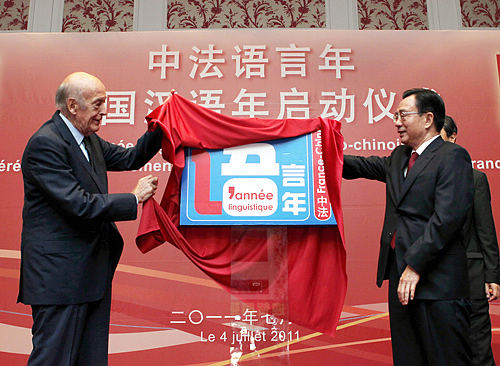|
 |
|
CULTURAL EXCHANGES: He Guoqiang, a member of the Standing Committee of the Political Bureau of the Communist Party of China, and former French president Valery Giscard d'Estaing inaugurate the Chinese Language Year in France in Paris on July 4 (GAO JING) |
Oil Spill
China's State Oceanic Administration (SOA) said on July 5 U.S. energy giant ConocoPhillips was responsible for an oil spill in the country's northern sea area.
The leaks, which occurred in June in the Penglai 19-3 oilfield in the Bohai Bay, contaminated an area of 840 square km and caused "a certain level" of damage to the nearby ocean environment, said the administration.
The field is being drilled by ConocoPhillips China, a subsidiary of ConocoPhillips, under a joint development agreement with the China National Offshore Oil Corp., the country's largest offshore oil producer.
SOA said oil seepage was first reported to its North China Sea Branch by ConocoPhillips on June 4, with another incident reported on June 17. The leakage was brought under control by June 21.
The administration said the seepage from platform-B was caused by drilling using hydraulic pressure, while the leak from platform-C was due to a surge in the well.
Land Reserves
China has 7.34 million hectares of "reserve land" that can be developed into arable land, the Ministry of Land and Resources said in a research report published on July 4.
The report said this reserve land is mainly in dry areas in the northern and western parts of the country.
But Yan Zhiyao, head of the Arable Land Protection Department of the ministry, said it would be a mistake for China to rely on large-scale development of the reserve land.
"China should improve the quality of arable land rather than increase the quantity," he said.
To ensure grain security, China has set a "redline" to guarantee its arable land never falls below 120 million hectares. It is edging close to the redline, with just 121.73 million hectares available, government data showed in February.
Old-age Allowance
China's old-age allowance system had expanded to 14 provincial-level regions, up from six one year ago, said the Ministry of Civil Affairs.
Recipients of the old-age allowance, which is available for people aged above 80 years, now number 8 million.
Minister Li Liguo said the ministry would continue to push other provincial-level regions to introduce the system, so as to better support elderly residents to meet their daily needs.
China currently has a total of 18.99 million residents older than 80 years.
Dinosaur Museum
China's first tyrannosaurus museum opened in east Shandong Province on July 1.
Construction of the museum, covering 30,000 square meters, began in early 2010 after Asia's largest and China's only tyrannosaurus was unearthed in Zhucheng in the province.
The museum features hi-tech facilities to exhibit the skeletons of the tyrannosaurus and other dinosaurs.
A large number of dinosaur fossils has been found in Zhucheng since 2008. The city is home to several dinosaur museums, including the Cretaceous Dinosaur Geopark, Huanglong Valley Dinosaur Footprint Museum, the Zhucheng Dinosaur Museum and the Dinosaur Egg Museum.
Opening-up Pledge
Northwest China's Xinjiang Uygur Autonomous Region has pledged to accelerate its development by further opening up.
The regional government was drafting a development plan that focuses on "westward opening up," said Nur Bekri, Chairman of the regional government, at a symposium on Xinjiang's economic policy on July 4.
Xinjiang has forged economic and trade relationships with 160 countries and regions. It has 29 open ports to neighboring countries and 12 national-level industrial zones. The Sino-Kazakhstan oil pipeline and the Turkmenistan-Uzbekistan-Kazakhstan-China gas pipeline have been completed and are now operational. Altogether 308 enterprises that rank among the world's top 500 companies and China's 500 leading enterprises had entered Xinjiang by the end of 2010, an increase of 113 from 2009. | 